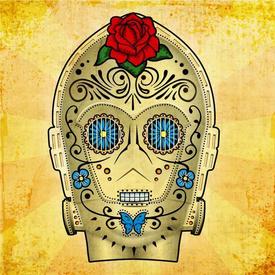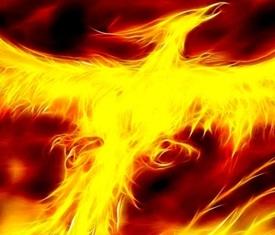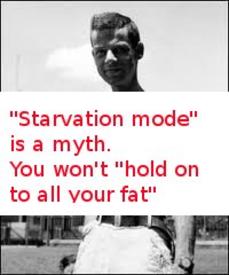How to low carb but not be on Atkins?
Replies
-
FunkyTobias wrote: »Why do you think this matters in this case?
Which diet do you think is more representative of the traditional Inuit diet? The one studied 80 yrs ago or one studied today?
The lack of analytical facilities in the old study isn't helpful, I remain confused as to what they measured in blood and how in order to determine the level of ketosis. I can see how fresh meat eaten while warm and fresh organs would be a carbohydrate source.
We had an interesting TV documentary on some remote Arctic community - in Russia I think - where one guy had a noticeably different cholesterol profile to the others, turned out his wife made cakes and he was eating a lot of "Western" or "modern" foods rather than the traditional hunter diet.
It would be fair to assume that we've screwed over the traditional diet of many communities in the last 100+ years.
Notice that there is a lot missing from the text so the methodology wasn't there but you should be able to find the study in a school library. Remember, however, that 1928 wasn't the dark ages of science and keto diets have been used since the 1920's for treatment of epilepsy and they have been able to measure ketones in the blood for a long time just as we have been able to measure glucose and fat in the blood for a long time.
Inuit don't eat their meat warm, they mix it on the ground with snow and it's actually quite good.0 -
-
I am not even sure that in 1928 they knew about the process of gluconeogenesis, where glucose is manufactured from labile protein when you are in the fat burning mode.
Of course they did but its not germain please stick to the issue. They looked to see if they were in ketosis and found they were not.0 -
I don't deliberately aim to eat low carb. Ultimately to me, if I have the calories for it that day, I can eat it.
In practice, I do mostly eat low carb. In the last month, I've eaten a low of 35 carbs and a high of 178 with an average daily level of 80. That's above Atkins reducing levels, but certainly any dietitian would consider it low carb.
The reason for this is that I try to focus my meals around meat and veggies, throw in some fruit when I want something sweet and otherwise not sweat it too much. I do tend to get hungry a bit fast after grains, but that sure as hell doesn't keep me away from the occasional sushi meal.0 -
I've lost 101 pounds on the Insulin Resistance Diet. It is a lower carb diet but it just taught me how to properly proportion my meals. My diary is set to 40 protein - 30 carbs - and 30 fat. I try to eat the sugar amount the website gives me.
I eat 7 protein for every 15 carbs and my carbs do not exceed 30 at any meal. This is essentially a diabetic diet but it doesn't limit the foods that I eat. I still eat breads and cereals, just at a much smaller amount.
Example Meal Plan:
Breakfast - 1 brown egg w/ 1 egg white, 2 tostada shells, cheese, gucamole, and TONS of veggies. I also eat a lot of Turkey sausage with cereal or grits.
Lunch - "Dump" salad with left over dinner eat and tons of veggies. My carb would consist of a fruit.
Dinner - Turkey Kielbasa Sausage with roasted veggies. Carb could be a half baked potato or small roll.
Snacks - High protein yogurt, Quest bars, lunch meat with veggies, peanuts/cheese/lunch meat, cottage cheese with cucumbers and tomatoes0 -
I am not even sure that in 1928 they knew about the process of gluconeogenesis, where glucose is manufactured from labile protein when you are in the fat burning mode.
Actually the "ketogenic diet" was coined as a term in 1921, by Russel Wilder, a guy working with the Mayo Clinic. Research was done earlier that year that noticed beta-hydroxybutyrate, acetoacetate, and acetones produced in the liver of people who had uncontrolled diabetes or ate a low-carbohydrate diet.
(source: Wheless JW. History and origin of the ketogenic diet (PDF). In: Stafstrom CE, Rho JM, editors. Epilepsy and the ketogenic diet. Totowa: Humana Press; 2004. ISBN 1-58829-295-9. You can probably view or download it here. http://www.springer.com/cda/content/document/cda_downloaddocument/9781588292599-c2.pdf)
Fasting was used as a precursor in the treatment of epilepsy as far back as 400 BC, though they didn't understand the internal processes occurring as we do now.
It was the early 1900s but it wasn't the dark ages.
0 -
Wheelhouse15 wrote: »Of course they did but its not germain please stick to the issue. They looked to see if they were in ketosis and found they were not.
Which ketone did they measure in what body fluid ?
0 -
Wheelhouse15 wrote: »Of course they did but its not germain please stick to the issue. They looked to see if they were in ketosis and found they were not.
Which ketone did they measure in what body fluid ?
Pg 468, please read rather than asking me these questions as the study provides those answers. I have provided the link so that people can get the source rather than second hand information. The link is on the JBC and there are other resources you can search, it's a great reference.
ETA BTW you can check up a follow up study in 1932 jbc.org/content/99/1/279.full.pdf+html?sid=1487e51d-5480-4f82-94a1-784a3f252ba9, which shows that Inuit are less likely to enter ketosis than others during a fast in the cold.0
This discussion has been closed.
Categories
- All Categories
- 1.4M Health, Wellness and Goals
- 398.1K Introduce Yourself
- 44.7K Getting Started
- 261K Health and Weight Loss
- 176.4K Food and Nutrition
- 47.7K Recipes
- 233K Fitness and Exercise
- 462 Sleep, Mindfulness and Overall Wellness
- 6.5K Goal: Maintaining Weight
- 8.7K Goal: Gaining Weight and Body Building
- 153.5K Motivation and Support
- 8.4K Challenges
- 1.4K Debate Club
- 96.5K Chit-Chat
- 2.6K Fun and Games
- 4.8K MyFitnessPal Information
- 12 News and Announcements
- 21 MyFitnessPal Academy
- 1.5K Feature Suggestions and Ideas
- 3.2K MyFitnessPal Tech Support Questions





